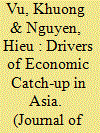|
|
|
Sort Order |
|
|
|
Items / Page
|
|
|
|
|
|
|
| Srl | Item |
| 1 |
ID:
184213


|
|
|
|
|
| Summary/Abstract |
The relationship between economic integration and income inequality is extremely contentious due to its complicated impact across key channels of globalization. This paper analyses the distributional effects of globalization through foreign direct investment (FDI) inflow and foreign trade (FT) volume. Data collected from Vietnam over the 2006–16 period provide evidence in support of the government's advocacy efforts to join the global economy. The two-step system generalized method of moments is used to construct the key estimate for this analysis with two cases: simultaneous effect and single causal effect. The findings show that while FDI worsens inequality, FT counteracts this effect to a greater magnitude, and the aggregate impact of globalization on inequality is negative. As openness is found to be generally beneficial to Vietnam's economy in terms of income distribution, this study also examines potential policies related to the country's globalization ambitions.
|
|
|
|
|
|
|
|
|
|
|
|
|
|
|
|
| 2 |
ID:
184218


|
|
|
|
|
| Summary/Abstract |
The relationship between economic integration and income inequality is extremely contentious due to its complicated impact across key channels of globalization. This paper analyses the distributional effects of globalization through foreign direct investment (FDI) inflow and foreign trade (FT) volume. Data collected from Vietnam over the 2006–16 period provide evidence in support of the government's advocacy efforts to join the global economy. The two-step system generalized method of moments is used to construct the key estimate for this analysis with two cases: simultaneous effect and single causal effect. The findings show that while FDI worsens inequality, FT counteracts this effect to a greater magnitude, and the aggregate impact of globalization on inequality is negative. As openness is found to be generally beneficial to Vietnam's economy in terms of income distribution, this study also examines potential policies related to the country's globalization ambitions.
|
|
|
|
|
|
|
|
|
|
|
|
|
|
|
|
| 3 |
ID:
184215


|
|
|
|
|
| Summary/Abstract |
This paper conducts a comprehensive examination of the sources of economic growth and catch-up of ASEAN countries since the Asian Financial Crisis, with comparative views of China and India. The study employs different decomposition frameworks to gain insights into the drivers of the Association's economic performance over the 1997–2017 period. Three findings are most notable. First, all ten member states, except for Brunei, recorded a strong catch-up performance, with labour productivity being the leading driver in most countries. Second, the drivers of labour productivity catch-up exhibit some distinctive patterns among countries, which depend on the level of income and economic structure. Third, in all decomposition analyses, ASEAN countries are well below China and India across sources of growth, which tends to suggest that countries in the grouping could improve their performance by enhancing market integration and policy coordination. Although the long-term prospect of ASEAN is bright, the COVID-19 pandemic and the recent military coup in Myanmar have indicated that the road to future prosperity of the region is expected to face formidable challenges.
|
|
|
|
|
|
|
|
|
|
|
|
|
|
|
|
| 4 |
ID:
184216


|
|
|
|
|
| Summary/Abstract |
This research investigates the significance of technological innovation for Thailand's industrial development through equity participation in the form of foreign direct investment (FDI). The pecking order theory suggests that to finance technological upgrading, firms tend to prioritize internal funding, and use debt and equity financing as the last resort. In the context of incessant technological change, however, equity financing might be a better choice. This research highlights some aspects of how that is the case by analysing firm-level performance data from Thailand and then conducting in-depth interviews with top executives from several companies located in the Eastern Economic Corridor (EEC). We find that the conventional pecking order theory does not hold when it comes to external financing decisions. The interview insights reveal that, while a majority of companies prioritize internal financing, capturing technology (as intangible assets) via equity as well as non-equity linkages with foreign firms is also observed. Given that technological upgrading can result from FDI inflows by foreign firms, a truly "joint" nature of equity and non-equity forms of investment projects would serve as a win-win option for Thai and foreign firms, especially under the "Thailand 4.0" policy framework.
|
|
|
|
|
|
|
|
|
|
|
|
|
|
|
|
| 5 |
ID:
184217


|
|
|
|
|
| Summary/Abstract |
This paper reassesses the impact of the residential electricity tariff reform implemented in 2012 on the distributional equity and fiscal cost of electricity subsidies in Brunei. Using data from the latest Household Expenditure Survey (HES) conducted in 2015/16, the study estimates that the poorest 20 per cent of households receive 18 per cent of total electricity subsidies, which is considerably larger than the previously estimated share of 11 per cent based on the 2010/11 HES data. This, in part, reflects behavioural changes induced by the reform to an increasing block tariff (IBT), as wealthier households reduce their electricity usage due to higher per-unit costs at higher levels of consumption while poorer households increase their usage as the tariff cost is cheaper in the first consumption block. Concomitantly, the fiscal cost of electricity subsidies has declined by more than 20 per cent following the tariff change. Yet, simulations of alternative reform scenarios show that there are substantial welfare gains and cost savings from refining the IBT structure, using a volume-differentiated tariff, or providing targeted cash transfers. The overarching message is that improving the design of subsidy schemes or introducing targeted transfers can achieve distributional equity and fiscal objectives more efficiently than existing electricity subsidies.
|
|
|
|
|
|
|
|
|
|
|
|
|
|
|
|
| 6 |
ID:
184214


|
|
|
|
|
| Summary/Abstract |
The study provides evidence on the transition and growth of the formal sector in the Indonesian economy. It utilizes data from the National Labour Force Survey (Sakernas) for tracking the previous work status of labourers as formal or informal workers. The study also examines the implications of formalization of employment for the different rates of earnings of formal sector workers, given their human capital characteristics and different industries of employment. The study finds that the growth of employment in the formal sector is mainly the result of the entry of younger and better educated workers. Although there is some mobility from the informal to the formal sector, the results show that individuals who were previously working in the informal sector are less likely to move to the formal sector. In terms of earnings, there is evidence of scarring effects: individuals who are initially in the formal sector earn more than individuals who are initially in the informal sector.
|
|
|
|
|
|
|
|
|
|
|
|
|
|
|
|
|
|
|
|
|